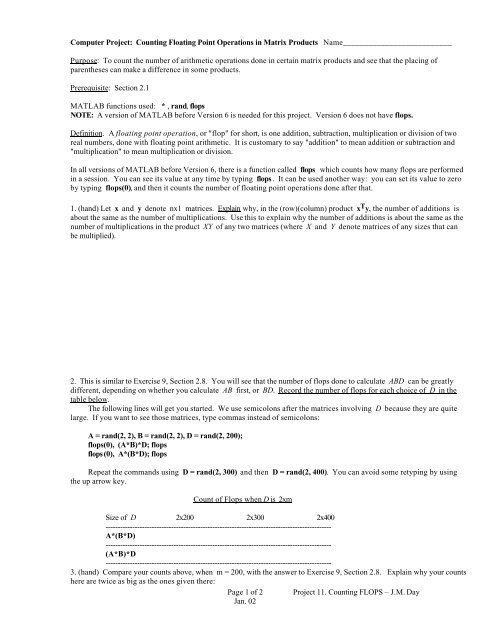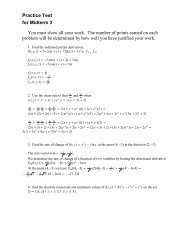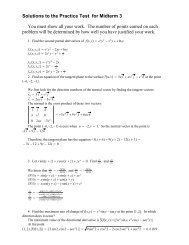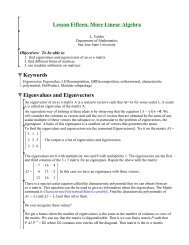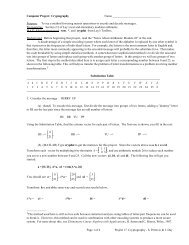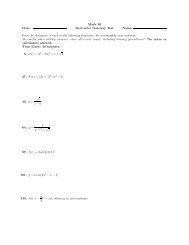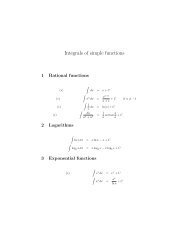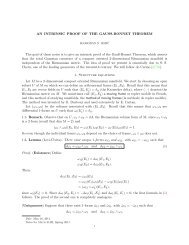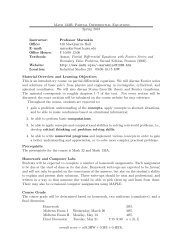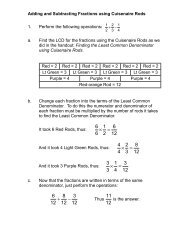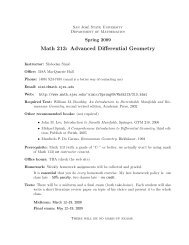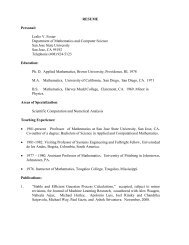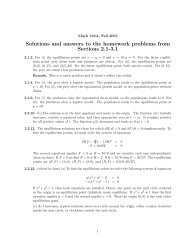11. Counting Floating Point Operations in Matrix Products
11. Counting Floating Point Operations in Matrix Products
11. Counting Floating Point Operations in Matrix Products
You also want an ePaper? Increase the reach of your titles
YUMPU automatically turns print PDFs into web optimized ePapers that Google loves.
Computer Project: <strong>Count<strong>in</strong>g</strong> <strong>Float<strong>in</strong>g</strong> <strong>Po<strong>in</strong>t</strong> <strong>Operations</strong> <strong>in</strong> <strong>Matrix</strong> <strong>Products</strong> Name__________________________<br />
Purpose: To count the number of arithmetic operations done <strong>in</strong> certa<strong>in</strong> matrix products and see that the plac<strong>in</strong>g of<br />
parentheses can make a difference <strong>in</strong> some products.<br />
Prerequisite: Section 2.1<br />
MATLAB functions used: * , rand, flops<br />
NOTE: A version of MATLAB before Version 6 is needed for this project. Version 6 does not have flops.<br />
Def<strong>in</strong>ition. A float<strong>in</strong>g po<strong>in</strong>t operation, or "flop" for short, is one addition, subtraction, multiplication or division of two<br />
real numbers, done with float<strong>in</strong>g po<strong>in</strong>t arithmetic. It is customary to say "addition" to mean addition or subtraction and<br />
"multiplication" to mean multiplication or division.<br />
In all versions of MATLAB before Version 6, there is a function called flops which counts how many flops are performed<br />
<strong>in</strong> a session. You can see its value at any time by typ<strong>in</strong>g flops . It can be used another way: you can set its value to zero<br />
by typ<strong>in</strong>g flops(0), and then it counts the number of float<strong>in</strong>g po<strong>in</strong>t operations done after that.<br />
1. (hand) Let x and y denote nx1 matrices. Expla<strong>in</strong> why, <strong>in</strong> the (row)(column) product x T y, the number of additions is<br />
about the same as the number of multiplications. Use this to expla<strong>in</strong> why the number of additions is about the same as the<br />
number of multiplications <strong>in</strong> the product XY of any two matrices (where X and Y denote matrices of any sizes that can<br />
be multiplied).<br />
2. This is similar to Exercise 9, Section 2.8. You will see that the number of flops done to calculate ABD can be greatly<br />
different, depend<strong>in</strong>g on whether you calculate AB first, or BD. Record the number of flops for each choice of D <strong>in</strong> the<br />
table below.<br />
The follow<strong>in</strong>g l<strong>in</strong>es will get you started. We use semicolons after the matrices <strong>in</strong>volv<strong>in</strong>g D because they are quite<br />
large. If you want to see those matrices, type commas <strong>in</strong>stead of semicolons:<br />
A = rand(2, 2), B = rand(2, 2), D = rand(2, 200);<br />
flops(0), (A*B)*D; flops<br />
flops (0), A*(B*D); flops<br />
Repeat the commands us<strong>in</strong>g D = rand(2, 300) and then D = rand(2, 400). You can avoid some retyp<strong>in</strong>g by us<strong>in</strong>g<br />
the up arrow key.<br />
Count of Flops when D is 2xm<br />
Size of D 2x200 2x300 2x400<br />
---------------------------------------------------------------------------------------------<br />
A*(B*D)<br />
---------------------------------------------------------------------------------------------<br />
(A*B)*D<br />
---------------------------------------------------------------------------------------------<br />
3. (hand) Compare your counts above, when m = 200, with the answer to Exercise 9, Section 2.8. Expla<strong>in</strong> why your counts<br />
here are twice as big as the ones given there:<br />
Page 1 of 2 Project <strong>11.</strong> <strong>Count<strong>in</strong>g</strong> FLOPS – J.M. Day<br />
Jan. 02
4. Modify the l<strong>in</strong>es typed <strong>in</strong> question 2 to do the same calculations for square matrices, of sizes 2x2, 5x5 and 10x10. Record<br />
your results:<br />
Count of flops when A, B and D are all the same shape<br />
Size of matrices 2x2 5x5 10x10<br />
------------------------------------------------------------------------------------------------------<br />
A*(B*D)<br />
------------------------------------------------------------------------------------------------------<br />
(A*B)*D<br />
------------------------------------------------------------------------------------------------------<br />
5. (hand) Expla<strong>in</strong> why rearrang<strong>in</strong>g parentheses made a difference <strong>in</strong> question 2 but no difference <strong>in</strong> question 4.<br />
Page 2 of 2 Project <strong>11.</strong> <strong>Count<strong>in</strong>g</strong> FLOPS – J.M. Day<br />
Jan. 02


